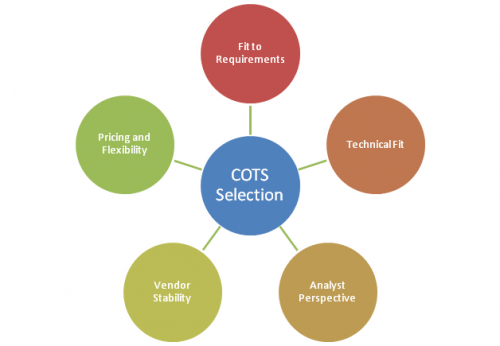Selecting the right Commercial Off-The-Shelf (COTS) vendor can be a tough decision to make. Even though many organizations have gone through the process several times, it is surprising how chaotic the process of selection can be time and time again. There are certain key factors every team has to consider in the process.
Fit for your requirements: This probably ranks on the top of your list. First, the team should have a clear set of requirements identified, ask vendors to preferably do a full day or a half a day workshop with the business and IT teams. The requirements should be ranked on a scale of 1-5 with 1 being the lowest fit and 5 being a perfect fit.
Tip 1: Ask the Vendor to rank themselves and provide qualitative responses to each requirement. Do not go solely by the vendor ranking but rather have the internal team rank the mapping and compare.

Tip 2: Never do a demo without involving business users and schedule the demo ahead of time.
Tip 3: Ideally the IT team should understand the requirements, relay the same to the vendor and work as a team before the presentations are delivered to the business. This saves a lot of time for business users and also gives a great impression about the value IT can bring to the table.
Technology Fit: This is too often the most ignored but a very important aspect in the grand scheme of things. If you are evaluating a recruitment application, you have to make sure it integrates with social media. You have to make sure it is in line with the IT group’s stated technology strategy. For example, if your strategy is to move to a cloud-based environment, you have to understand the vendors offering in a SAAS environment.
Tip 4: Ensure the technology strategy including database platforms, infrastructure platforms and other relevant information like integration strategy are shared with the vendor ahead of time. Rank the vendors on a scale of 1-5.
Tip 5: Always involve the IT Architect early in the selection process. This cannot be an afterthought.
Market Analysts perspective: Going through the analysts’ reports from Gartner and Forrester can make the selection process easy for your organization. They provide a great unbiased perspective on the vendors and, these days, business users also want to see the analyst perspective before they make a decision.
Tip 6: Analyst perspective is not the end of the road. Remember that the analysts also have only a limited amount of time to evaluate the vendor. They go through the dog and pony show, talk to references provided by vendor and have to make a quick evaluation themselves.
Referenceable customers in your space: Gone are the days when vendors can sell their product across verticals. These days every organization wants to see a product which has a significant referenceable customer base in their vertical. I think this is a sophistication to which some vendors still have to adapt. However, verticalized solutions tend to be a better fit for your requirements.
Tip 7: Do not just go by the references the vendor provides. They only give references who will have good things to say. Social media can be a great tool to identify and talk to other references as does general research on the internet.
Tip 8: While evaluating products, make sure you align it to resource availability within your organization and consulting resources. There might be a great product out there but if you cannot find good consulting or internal talent to implement it, you will run into huge roadblocks during the implementation.
Financial landscape and activity in the market: It is very important to analyze the financial landscape of the vendor. The generic questions could be a) how long have they been in the business, b) Are they publicly traded or privately owned, c) How profitable is the vendor, d) what is their re-investment strategy to improve the product and technology stack, and e) Is the vendor’s space going through a phase of consolidation or integration?
Pricing and flexibility: Last but not least, you have to make sure the vendor applications are within your price range. Software companies have a huge margin for negotiation and their final prices can vary as much as 80% to the original price.
Tip 9: Keep the competitive dialog going. Let the vendor know a range of where they stand with competition. Always have more than one vendor till the final selection is made.
Tip 10: Flexibility is the most important aspect in vendor selection. You want to make sure the product vendor is going to work with you throughout the process. Insist on the vendor putting their skin in the game by either making an investment in the form of a program manager or a commitment to roll critical customizations back into the product.
Which vendor is finally selected in the process might go beyond these factors and might be influenced by factors like business relationships, future growth potential, etc. However, following these simple steps will make the process efficient and effective.
Copyright © 2010 Sarat Varanasi


